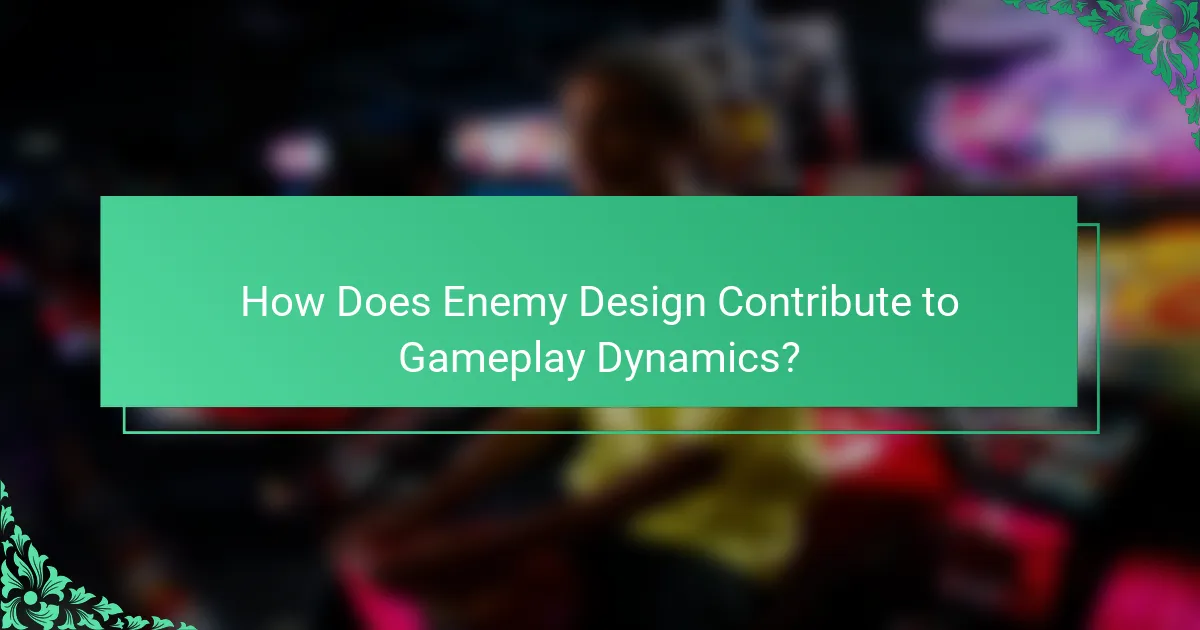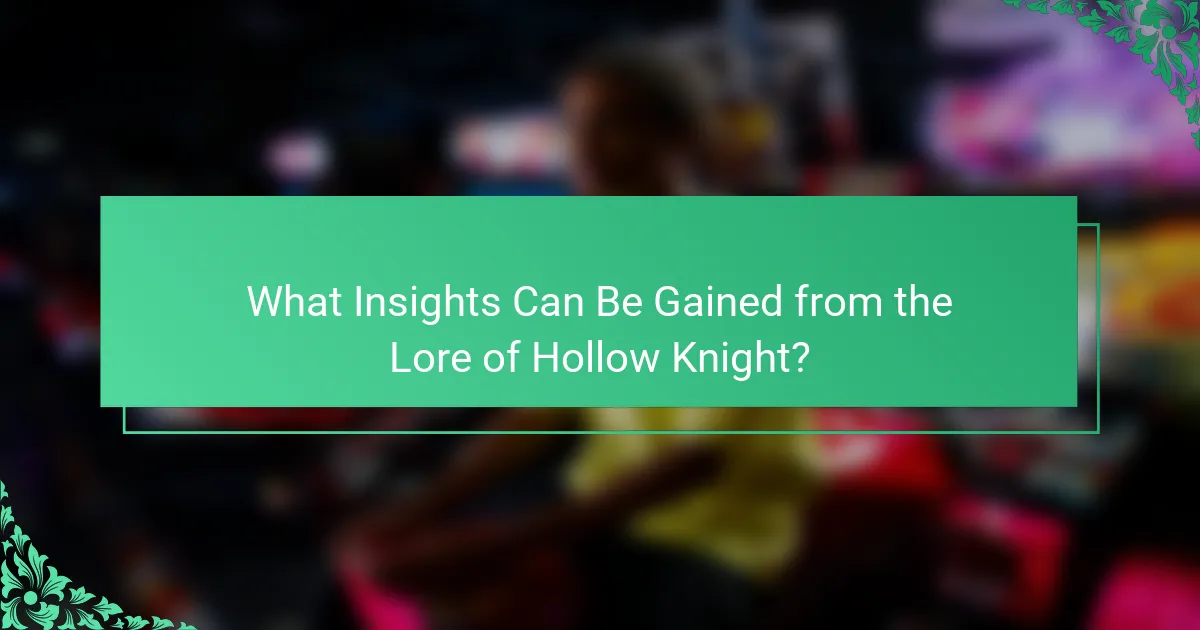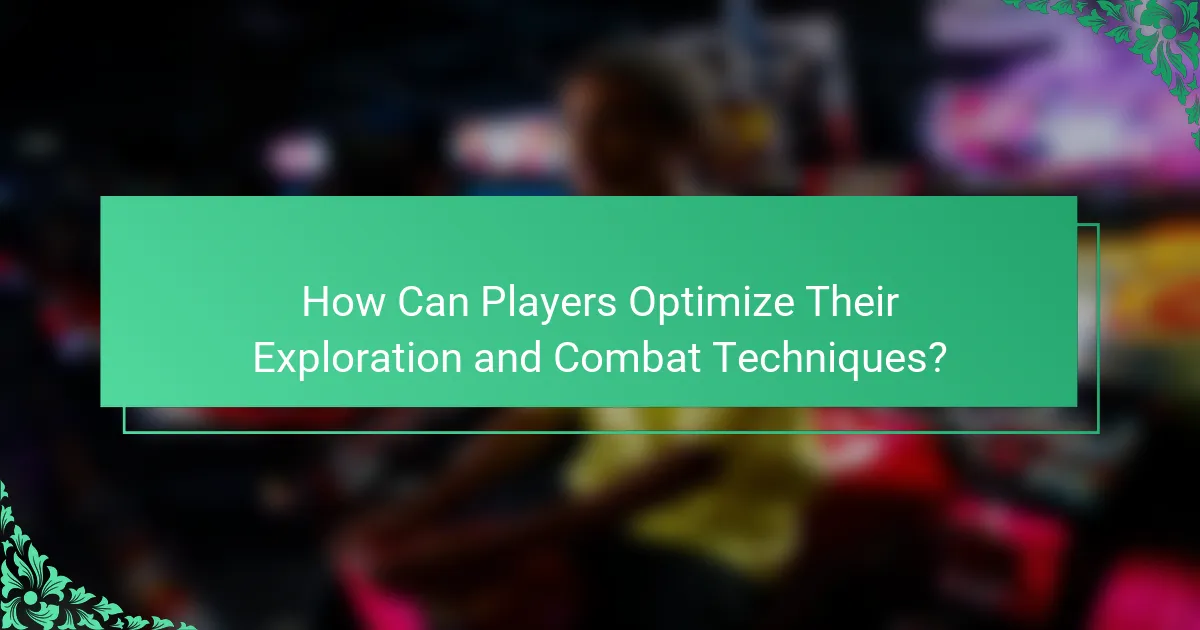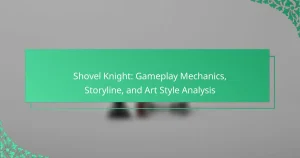Hollow Knight offers players a rich experience through its exploration techniques, intricate enemy design, and compelling lore. Mastering movement skills like wall climbing and super dash enhances exploration. Unique enemy behaviors challenge players to adapt their strategies. Delving into the lore reveals the history of Hallownest, enriching gameplay and providing context for the game’s narrative.

What Exploration Techniques Enhance Gameplay in Hollow Knight?
Exploration techniques in Hollow Knight enhance gameplay by promoting curiosity and discovery. Players can utilize techniques such as wall climbing, super dash, and the use of specific charms to access hidden areas. These methods encourage thorough exploration, revealing secret passages and lore insights. Additionally, the intricate enemy design requires players to adapt their strategies, enhancing engagement and immersion in the game’s expansive world.
How Do Movement Mechanics Influence Exploration?
Movement mechanics significantly enhance exploration in Hollow Knight by allowing players to navigate complex environments. Techniques such as wall jumping and dashing enable access to hidden areas and shortcuts. Enemy design complements this by creating obstacles that require strategic movement to overcome. Lore insights deepen the experience, encouraging players to explore every nook for story elements. This synergy between movement mechanics, enemy design, and lore fosters a rich exploration experience.
Which Tools and Abilities Are Essential for Navigating the World?
Essential tools and abilities for navigating the world in Hollow Knight include the Mothwing Cloak, which enables dashing, and the Crystal Heart for gliding. These abilities facilitate exploration and combat, enhancing player movement.
The game features various tools like the Dream Nail for lore insights and the Lantern to illuminate dark areas. Each tool is designed to interact with the environment uniquely, revealing hidden paths or secrets.
Enemy design varies, with some requiring specific abilities to defeat, while others test the player’s navigation skills. Understanding enemy mechanics is crucial for successful exploration and progression.
Lore insights are gathered through exploration and interactions, enriching the narrative experience. Players uncover the history of Hallownest, providing depth to the gameplay and enhancing immersion.
What Role Does Map Design Play in Player Exploration?
Map design significantly enhances player exploration in Hollow Knight by guiding navigation and revealing lore. Thoughtfully crafted maps create a sense of mystery, encouraging players to uncover hidden areas and secrets. The interplay between map layout and enemy placement further enriches the exploration experience, as players must adapt their strategies to navigate diverse environments. Additionally, intricate designs often hint at the game’s lore, deepening player engagement and understanding of the world. This design approach fosters a rewarding exploration cycle, where players are motivated to discover and learn more about the game’s rich narrative.
How Can Players Utilize Environmental Cues for Better Navigation?
Players can utilize environmental cues to enhance navigation in Hollow Knight by observing visual and auditory signals. The game’s design incorporates distinct landmarks, color variations, and sound effects that guide players through the intricate world. For example, certain areas feature unique flora or architecture that signal proximity to important locations. Additionally, the presence of specific enemies or environmental hazards can indicate the level of difficulty or the need for caution. By paying attention to these cues, players can make informed decisions about exploration routes and strategies.
What Strategies Help in Overcoming Exploration Challenges?
Effective strategies for overcoming exploration challenges in Hollow Knight include mastering movement mechanics, utilizing map markers, and leveraging environmental clues. Players can enhance their navigation by learning the abilities of the Knight, such as wall jumping and dashing. Using the map to mark areas of interest helps in tracking progress and identifying unexplored regions. Additionally, paying attention to visual and auditory cues can reveal hidden paths and secrets, enriching the exploration experience.

How Does Enemy Design Contribute to Gameplay Dynamics?
Enemy design significantly enhances gameplay dynamics in Hollow Knight by creating diverse challenges and encouraging exploration. Unique enemies possess distinct attack patterns and behaviors, requiring players to adapt their strategies. This design fosters engagement, as players must learn and master each enemy’s mechanics to progress.
Additionally, enemy placement often leads to hidden areas, rewarding exploration with lore insights and upgrades. The interaction between enemy design and environmental elements creates a cohesive experience, deepening immersion and enhancing the overall narrative. As a result, players are motivated to explore the game’s intricate world while overcoming various adversaries.
What Are the Key Attributes of Enemy Types in Hollow Knight?
Hollow Knight features diverse enemy types, each with unique attributes that enhance gameplay. Key attributes include attack patterns, health points, and weaknesses.
1. Attack Patterns: Enemies exhibit distinct behaviors, such as charging or ranged attacks.
2. Health Points: Varies significantly among enemy types, impacting their durability.
3. Weaknesses: Certain enemies are vulnerable to specific abilities or charms, influencing combat strategies.
4. Environmental Interaction: Some enemies adapt to their surroundings, altering their attack style.
5. Lore Significance: Each enemy type often ties into the broader narrative, adding depth to the exploration experience.
6. Aesthetic Design: Visual elements reflect the game’s art style, contributing to the overall atmosphere.
How Do Enemy Patterns Affect Player Strategy?
Enemy patterns significantly influence player strategy in Hollow Knight by dictating movement, attack timing, and resource management. Players must adapt their tactics based on enemy behaviors, such as attack sequences and positioning. For example, understanding a foe’s attack pattern allows players to dodge effectively and counterattack at optimal moments.
Additionally, the design of enemies encourages exploration by rewarding players with unique abilities or items upon defeat. This creates a cycle where mastering enemy patterns leads to deeper exploration and lore insights. As players progress, they encounter rare enemies that require specific strategies, further enhancing the gameplay experience.
Overall, the interaction between enemy design and player strategy fosters a dynamic environment, essential for mastering Hollow Knight’s challenges.
What Unique Boss Encounters Challenge Players Differently?
Unique boss encounters in Hollow Knight challenge players through varied mechanics and design. Each boss requires distinct strategies, emphasizing exploration and adaptability. For example, the Radiance tests players’ mastery of movement and attack patterns, while the Hollow Knight focuses on timing and precision. These encounters enhance lore by integrating narrative elements into gameplay, making each battle a significant part of the player’s journey. Players must learn unique patterns and adapt to different environments, reinforcing the game’s core themes of exploration and discovery.
How Does Enemy Design Reflect the Lore of the Game?
Enemy design in “Hollow Knight” intricately reflects the game’s lore by embodying the themes and histories of Hallownest. Each enemy type is a manifestation of the kingdom’s past, showcasing its decline and the impact of the infection. For example, the Mantis Lords symbolize the once-honorable guardians of the Mantis tribe, now corrupted by the chaos of the world. Unique attributes, such as the distinct fighting styles of each enemy, reinforce their lore significance, creating a deeper connection between gameplay and narrative. This design approach enhances player immersion, making encounters feel like a direct confrontation with Hallownest’s tragic history.

What Insights Can Be Gained from the Lore of Hollow Knight?
The lore of Hollow Knight provides rich insights into its world, characters, and themes. Players uncover a deep narrative through exploration, which reveals the history of Hallownest and its fallen kingdom.
The game’s enemy design reflects the lore, showcasing creatures that embody the struggles and tragedies of the past. Each enemy tells a story, enhancing the player’s understanding of the world.
Unique attributes, such as the connection between the Knight and the Radiance, illustrate complex themes of sacrifice and duty. This narrative depth encourages players to engage with the environment and piece together the history of Hallownest.
As a result, the lore of Hollow Knight not only enriches gameplay but also invites players to reflect on broader themes of loss and redemption.
How Does the Story Unfold Through Environmental Storytelling?
Environmental storytelling in “Hollow Knight” unfolds through immersive world design, hidden lore, and environmental cues. Players explore interconnected areas, revealing the history of Hallownest through visual elements and subtle details. Each location conveys emotions and narratives, enriching the gameplay experience. For example, abandoned structures and defeated enemies hint at past events and the kingdom’s decline. This storytelling method deepens player engagement and encourages exploration, enhancing the overall narrative.
What Are the Major Themes Explored in the Game’s Lore?
Hollow Knight’s lore explores themes of sacrifice, identity, and the cyclical nature of life. The game delves into the struggles of the insect inhabitants of Hallownest, their connections, and the consequences of their choices. The theme of isolation is prevalent, highlighting the loneliness of characters like the Knight and Hornet. Additionally, the lore examines the impact of power and ambition, as seen through figures like the Radiance and the Pale King, showcasing how their desires shape the world around them.
How Do Characters and Their Backgrounds Enhance the Narrative?
Characters and their backgrounds significantly enhance the narrative by adding depth and emotional resonance. In “Hollow Knight,” each character’s unique backstory contributes to the game’s lore, creating a rich tapestry that engages players. For instance, the tragic histories of the Knight and the Hollow Knight evoke empathy, making players more invested in their journeys. The design of enemies often reflects their backgrounds, showcasing their motivations and struggles, which further enriches the gameplay experience. This connection between character design and narrative fosters a more immersive exploration of the game’s world.
What Rare Lore Elements Are Hidden Throughout the Game?
Hollow Knight features various rare lore elements that enhance the game’s depth. Hidden items, secret dialogue, and environmental storytelling reveal the history of Hallownest and its inhabitants. For example, the Dream Nail unlocks unique lore insights when used on specific characters, providing a deeper understanding of their backgrounds. Additionally, certain areas contain hidden messages and forgotten memories that enrich the narrative experience. These elements encourage exploration and offer players a chance to uncover the mysteries of the game world.

How Can Players Optimize Their Exploration and Combat Techniques?
Players can optimize their exploration and combat techniques in Hollow Knight by mastering movement, understanding enemy patterns, and utilizing upgrades effectively.
Effective movement techniques include dashing, wall-jumping, and using the Crystal Heart ability. These skills enhance mobility and allow players to navigate complex environments. Understanding enemy design is crucial; players should learn attack patterns and weaknesses to exploit during combat.
Upgrades, such as charms and abilities, significantly impact gameplay. Choosing the right charms can enhance combat efficiency and exploration capabilities. For example, the Quick Focus charm accelerates healing, while the Dashmaster charm improves movement speed.
Lastly, engaging with the game’s lore provides valuable context that can influence gameplay strategies. Exploring hidden areas often rewards players with lore insights that enhance their understanding of the game’s world and mechanics.
What Best Practices Should Players Follow for Efficient Exploration?
Players should prioritize exploration techniques that enhance efficiency and understanding of Hollow Knight’s world. Key practices include utilizing the map, mastering movement abilities, and engaging with lore through environmental storytelling.
First, regularly update the in-game map to track explored areas and identify new paths. This helps players avoid backtracking and discover hidden secrets. Next, mastering movement abilities, such as dashing and wall-jumping, allows for quicker navigation and access to challenging platforms.
Additionally, players should engage with the environment and enemies to gain insights into the lore. Each area features unique designs and enemy behaviors that provide context about the world. Observing these elements can lead to a richer gameplay experience.
Lastly, maintaining a balance between exploration and combat is essential. Players should approach enemies strategically, using their knowledge of enemy patterns to navigate the landscape effectively while minimizing health loss.
Which Common Mistakes Should Be Avoided During Gameplay?
Players should avoid common mistakes like neglecting exploration, underestimating enemy patterns, and ignoring lore clues. Failing to explore thoroughly can lead to missed upgrades and shortcuts. Not recognizing enemy attack patterns can result in unnecessary deaths. Overlooking lore insights can diminish the game’s depth and enjoyment. Prioritizing these aspects enhances gameplay and overall experience.
What Expert Tips Can Enhance Player Experience in Hollow Knight?
To enhance player experience in Hollow Knight, focus on exploration techniques, enemy design, and lore insights.
First, utilize the map system effectively. Mark areas of interest and revisit them after acquiring new abilities. This encourages thorough exploration and discovery of hidden paths.
Second, study enemy patterns. Understanding their attack styles helps in developing effective strategies for combat. This knowledge is crucial for overcoming challenging foes.
Lastly, immerse yourself in the lore. Pay attention to environmental storytelling and character dialogues. This deepens the connection to the game’s world and enriches the overall experience.


